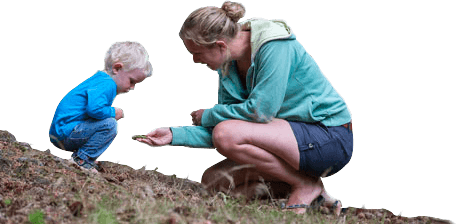6. Objective – An Inclusive National Park
Re:New Forest – Partnership Plan
An Inclusive National Park Outcome: People within reach of the New Forest, of all backgrounds, abilities and socio-economic groups, value the National Park as an important part of their lives and seek to care for it.
Why is it important?
![]()
People need nature and culture for their physical, mental and spiritual health. The future of the New Forest depends on future generations understanding and valuing this internationally-important landscape – and helping to care for it. Education officers across Forest organisations teach 10,000 children and young people a year with sessions tailored to learning about the New Forest and rangers work with thousands more through their family-focussed events and activities. Many more are engaged through the media, print and online platforms.
We want to encourage greater understanding and appreciation of the National Park, whilst ensuring minimum impact, and support the social and economic benefits that visitors bring in a sustainable way.
We also want to specifically help people who face barriers or particular challenges to access so that they can benefit equally from engagement with the National Park. Effective engagement, interpretation and communication programmes with new and existing partners will be required to ensure we are a National Park for all.
Our priorities
We will do this through a programme of work that:
3.1. Promotes Health and Wellbeing by:
3.1.1. Building a strong, mutually beneficial partnership between the health and environment sectors, including a five-year programme of ‘Health Education Fellowships’ and facilitating effective local networks
3.1.2. Addressing health inequalities locally and regionally through improved green space, targeted interventions and nature-based referrals
3.1.3. Increasing uptake of walking for health, inclusive cycling for health and volunteering for health programmes.
3.2. Connects People with Nature and Landscape by:
3.2.1. Removing barriers to participation and access – physical and perceived, e.g. affordable public transport
3.2.2. Recruiting more rangers, part of whose role is to help people understand and enjoy the New Forest, including apprentice rangers
3.2.3. Using data and evidence to create a more accurate picture of the current and possible users of the New Forest National Park and barriers to participation
3.2.4. Developing comprehensive and inclusive programmes of health and youth engagement and outreach to build relationships with diverse communities and audiences, including a Youth Action Project and bespoke education activity.
3.3. Leads inclusive place making, celebrates beauty and safeguards our cultural heritage by:
3.3.1. Assisting communities and local organisations to lead and shape cultural and natural heritage projects that foster identity and a sense of place
3.3.2. Bringing together cultural heritage and archaeological datasets, identifying gaps and surveying identified areas to achieve a complete picture for future management
3.3.3. Interpreting and disseminating landscape, cultural and natural heritage through specific outreach such as the New Forest Knowledge website.
Next page: 8. Objective – Team New Forest



